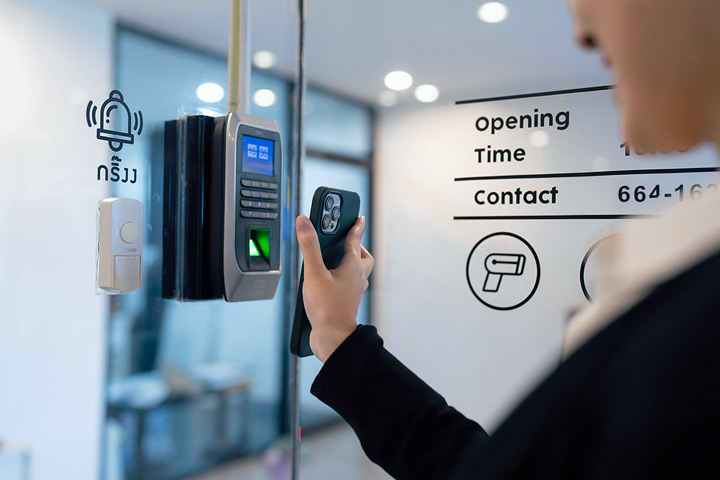What are Different Types of Access Control & How Are They Used?
 Access control is an essential security feature for any business as it regulates who can access a commercial building and where they can go within the space. Security technology constantly evolves, making for more robust and customizable solutions.
Access control is an essential security feature for any business as it regulates who can access a commercial building and where they can go within the space. Security technology constantly evolves, making for more robust and customizable solutions.
Below, we’ll look at the different types of access control, their features and potential limitations, and widespread use cases. By the end, you’ll know which access control solutions make the most sense for your business.
Access control basics
Access control is a security technique that regulates who or what can view or use resources within a commercial property. It’s essentially a fancy term for locking secure areas!
Access methods like keyfobs, mobile access, and biometric scans ensure that only authorized personnel can enter specific areas, protecting sensitive information and assets.
Commercial properties often employ multiple access control methods to safeguard against intruders. It minimizes the risk of unauthorized access, theft, and other security breaches. It also makes it possible to track the movement of employees and visitors throughout a commercial property.
Traditional entry control methods
Traditional access control methods, such as mechanical locks and keys or keyfobs and keycards, provide foundational security by requiring physical credentials for entry. Read on to learn about their common use cases and potential limitations.
Mechanical locks and keys
Mechanical locks and keys are the oldest forms of access control, relying on physical keys to lock and unlock doors. Small businesses, residential properties, and areas with lower security needs often rely on traditional mechanical locks and keys.
Their limitations include the risk of lost or duplicated keys and vulnerability to lock picking and unauthorized key copying, making them less secure than modern access control methods.
Keyfobs and keycards
Keyfobs and keycards are electronic access control devices that use RFID (Radio Frequency Identification) or magnetic stripe technology to grant entry when swiped or tapped against a reader.
Commonly used in offices, hotels, and secure facilities, they offer greater convenience and security than traditional locks by eliminating the need for physical keys and allowing for easy reprogramming and deactivation.
However, they can still be vulnerable to loss, theft, or cloning, and unauthorized individuals might gain access if the devices are not adequately protected.
Keycards and keyfobs also represent an administrative burden, as someone must be available to activate, deactivate, collect, or replace keycards and keyfobs if they are revoked or misplaced.
Advanced access control technologies
Advanced access control technologies, such as mobile access and biometric systems, leverage cutting-edge innovations to enhance security and convenience by using smartphones and unique biological traits for entry.
Mobile access control
Mobile access control utilizes smartphones as digital credentials, allowing users to unlock doors and secure areas via Bluetooth, NFC, or cloud-based apps. Modern office buildings, residential complexes, and hotels often use mobile access control.
It is popular because mobile credentials are convenient for most users and difficult (if not impossible) to share, enhancing overall security.
It offers significant advantages in convenience, as users can access multiple areas without carrying physical keys or cards. Remote management enables administrators to issue, revoke, or modify access permissions instantly from anywhere.
Biometric access control
Biometric access control uses unique biological traits, such as fingerprint scanners, facial recognition, and retina scans, to verify identities and grant access.
This technology is widely used in high-security environments like data centers, restricted areas, and government facilities due to its high accuracy and difficulty to forge.
The security benefits are significant, as biometric traits are unique to each individual. They reduce the risk of unauthorized access and enhance overall protection.
Multi-layered systems offer the most robust security
You can enhance security by combining multiple types of access control. Combining methods such as keycard and PIN or biometric and mobile access creates multiple barriers against unauthorized entry.
This redundancy significantly reduces the risk of breaches, as intruders would need to bypass several security measures.
These systems are particularly beneficial in high-stakes environments like corporate offices, healthcare facilities, and financial institutions, where protecting sensitive information and assets is crucial.
Choosing the right types of access control for your business
Choosing the right access control system for your business involves carefully assessing your security needs. You must consider factors such as the size of the facility, the number of employees, and the sensitivity of the information being protected.
Custom solutions are essential, as they allow for tailoring the access control system to effectively meet specific business requirements.
Consulting with a trusted security partner is crucial, as they can provide a professional assessment and ensure proper installation, optimizing the system’s effectiveness and reliability.
NEXT STEPS:
- Contact us today to learn more about security and surveillance for your business.
- Learn more about what home or business security means to us.
- Subscribe to our blog to stay informed about the latest security news and insight.

















